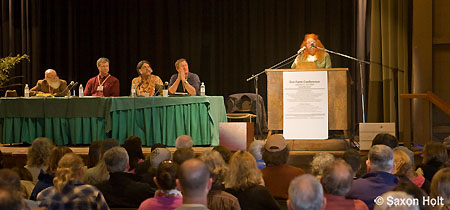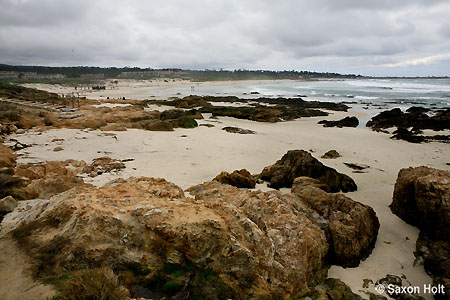I hope GGW readers will enjoy this lengthy post. Having just returned from my first Eco-Farm Conference I am full of new ideas.

This was the 29th conference put on by the Ecological Farming Association, long an advocate and resource for farmers seeking sustainable alternatives to the USDA. Listening to the discussions it became quite clear that this conference has been the catalyst for change in the entire organic farming industry.
For many years Eco-Farm has brought together, not just farmers but scientists, regulators, distributors, and activists who want to work together to facilitate sustainable agriculture. The term “Sustainable Agriculture” itself was the subject of a heated discussion this year as policy wonks from ANSI (American National Standards Institute) and Natural Resource Defense Council pleaded for understanding in their attempts to bring together some of the biggest names in the food industry toward a marketable and measurable definition of the term. The Organic Farming Research Foundation rep after saying “farmers have a 3000 year history of destroying the earth, with the best intentions” went on to say that for California organic farmers, sustainable standards “ain’t gonna happen”, using the logic that we don’t yet know what sustainable agriculture is, how can we come up with a finite way to measure it and find the regulators to enforce it ?
The conference was full of insight and revelations, resilience and optimism, philosophers and pundits. One of the best lines of the conference, in the closing plenary was uttered matter-of-factly by Jim Riddle long-time farmer, inspector, and policy analyst (seated second from left in the photo) “I’ve heard it said that if all the organic inspectors, certifiers, and regulators were laid end to end – it would be a good thing.” But more in keeping with the spirit of the conference, another panelist, farmer-philosopher Tom Willey (seated at far left) said “intimacy with our food is our future.”
Intimacy with food would certainly apply to “Edibilist” a new word coined by author William Emory. In his book “The Edges of Bounty- Adventures in the Edible Valley“, he describes an intentional involvement with the production, consumption, and sharing of food he found among small farmers around California’s Central Valley. With an intention toward sustainability, edibilists seek an intimacy with food that can also be seen in the renewed interest in heirloom varietals. Emory shared a presentation with Gary Nabhan whose book “Renewing America’s Food Traditions: Saving and Savoring the Continent’s 100 Most Endangered Foods” examines place-based foods that have been pushed aside by agribusiness.
And speaking of new words, I discovered ethicurean a word for lovers of SOLE food – sustainable, organic, local and ethical. Fellow bloggers will also find that ethicurean is also a fabulous site full of foodie news, commentaries, rants and humor. It seems odd to me that there was so little coverage of this in the garden blog world, and is about time we reached across the aisle to farmers to connect on issues.
The sharing of food and the revival of local varieties is also important to chefs who are raising the profile of food sustainability. The conference brought together 3 celebrity chefs to discuss their own efforts in educating the public about the importance of food system activism. Dan Barber (Blue Hill restaurant in New York), Annie Somerville (Greens in San Francisco), and Judy Wicks (White Dog Café in Philadelphia) each spoke about how chefs and farmers are making a difference in the public’s understanding of agriculture and local, sustainable economies.
The need to consider locally produced foods in the sustainability equation has led to the development of another new term, “foodshed” which refers to the agro-ecological footprint of any given region. I am sure we will hear more about regional foodsheds as farmers everywhere adapt to local conditions and regional tastes ; and as retailers see the savings of cost-effective local produce. I notice now, that local produced organic foods are almost the same price as foods that come to market by way of an agribusiness system that claims “efficiency” in producing, packing, and distributing food from many different sources.
The conference was life affirming and positive, there was very little negative push against agribusiness. This group spends all their time working hard for positive change, there is little time for negative distractions. Farmers tend to be optimists, despite the odds. And this group seems united in the belief their methods are the future. As our economy reinvents itself, organic farmers have a good degree of job security.

It is also easy to be upbeat when you are on vacation in one of the most beautiful places in the world. In the photo of Asilomar State Beach in Carmel California, you will (almost) see a group of farmers huddled together (at the edge of Spanish Bay way in the distance) in a closing circle as the conference concluded. These hard working farmers were there to see old friends and renew the passion for agricultural change many of them have brought about themselves. It was also a vacation for a couple days away from their fields.
Like most conferences, the days were full of workshops mostly geared toward sharing information and discussing new ideas. But unlike any conference I have attended, the food was supplied by the attendees. The cooks at the Asilomar Conference Center were bestowed the best that California organics could provide and were given recipes from some of the best cooks in the world. Somehow they served the 600 or so of the conference’s participants who stayed at the lodge’s delightfully TV and phone free rooms with speed and graciousness.
Ten meals came with the conference package and each is worth describing and should be a feature story in Gourmet magazine, but my own personal highlights included a dinner with “Juniper and Wild Mushroom Risotto Cakes with crushed pecans and fresh herbs”, “Sautéed Winter Greens with Melted Leeks”, “Maple Roasted Sweet Potatoes”, and “Arugula Salad with Roasted Beets and Goat Cheese”. How about that pasta salad lunch “Warm Ricotta Laced Penne with Butternut Squash, Sun-dried Tomatoes and French Lentils with Sage Pesto” ? And the soups ! the breads ! oh, and remember that “Toasted Barley, White Bean and Feta Salad with Marjoram” ?!
Ok back to reporting. Actually I can only report a fraction of what happened as there were dozens of presentations. But knowing how influential this conference is with the movers and shakers of organic farming, it is telling to list some of the titles to get an understanding of what issues are being discussed in the industry. This, after all, was my reason to attend. I may be a photographer by trade but I am a journalist who is curious about new ideas and I sense the biggest changes in horticulture will be coming from the sustainable farming movement.
There were presentations on soil as an organic system and new ideas on tillage. There were presentations on the organic flower industry, bees, renewable energy, carbon sequestration, biodiversity, genetically modified organisms, web selling, and many presentations in Spanish. I was quite impressed by the commitment to social justice in both presentations and awards. The conference awards include a Justie award honoring advocates for social justice in sustainable agriculture. This year it went to Dolores Huerta who, with Cesar Chavez, formed The United Farm Workers Association in 1962. Ms. Huerta accepted the award and then asked everyone to rally against a new farm bill that will dilute protections for workers using pesticides.
The conference seemed like a counterculture update from the dawn of the ecology movement except these are folks who did not drop out, they went to work practicing what was preached. Looking at wizened faces and gray hair it was no wonder there were several workshops on Transitions – how to let go of your farm, how to encourage future farmers. A number of the most successful farmers are now advisors and consultants. Perhaps the most respected of the group is Amigo Cantisano a seventh generation Californian.

Cantisano co-founded The Ecological Farming Association as well CCOF (California Certified Organic Farmers) and is a masterful organizer who has been selflessly spreading the gospel of organics for over 30 years, seen here smiling as another conference winds down.
Another pioneering organic farmer, Jim Riddle who has been the chair of National Organics Standards Board, concluded his statement at the closing plenary by summing up with ten words the words to live by for the future of sustainable agriculture: Integrate (organics into the wider economy, Stimulate (a green economy), Educate (ourselves and our children), Collaborate (universities, farmers, markets), Agitate (the movement), Motivate (youth and government), Validate (the benefits), Cultivate (the soil and personal relationships), Meditate (listen to the earth where wisdom comes from), Celebrate (our success, one another, and our very being).
All of us in horticulture, all of us who care about a sustainable planet, owe a debt to these farmers who keep pushing for change. The change they seek is not politically motivated but from a genuine concern for better food for themselves and their customers. Many expess farming as a honor. I felt humbled to be among such dedicated hard working folk and firmly believe our future depends on their success.
